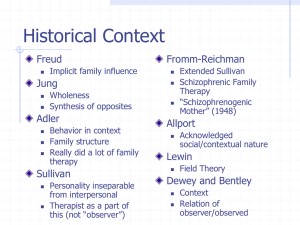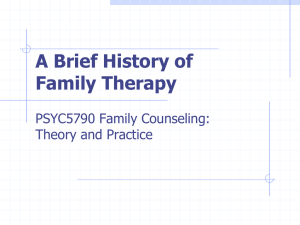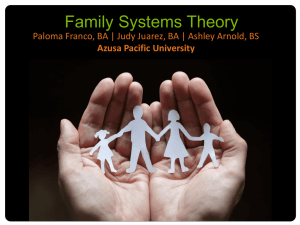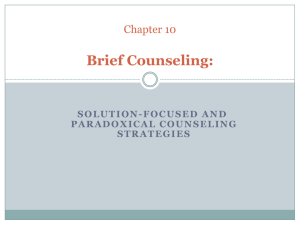Family Counseling Theory: Virginia Satir's Approach
advertisement
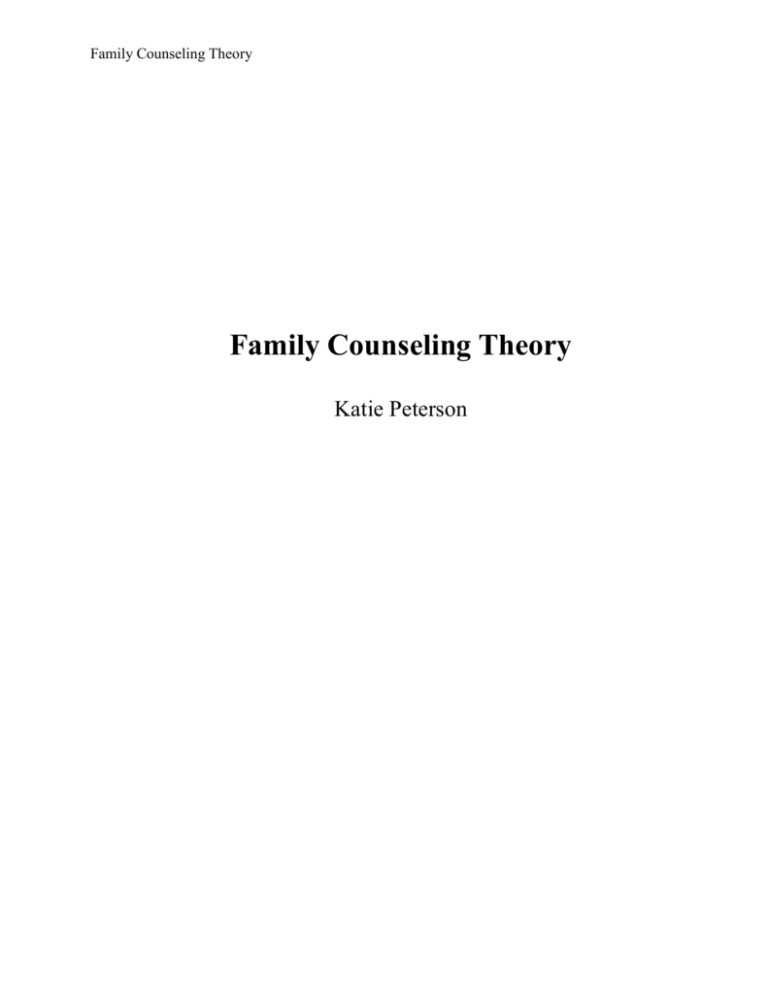
Family Counseling Theory Family Counseling Theory Katie Peterson Family Counseling Theory Family Counseling Theory Family therapy in a nutshell is a form of therapy in which the counselor works with the entire family at once instead of individual members. Often, a family therapist will even reschedule a session if one or more members of the family aren't present. The essential theory behind family therapy is that a family is a system made up of parts and a problem with one of the parts affects the entire system. Families try to maintain stability, if one member of the family does anything out of the "norm" for that particular family; the other members of that family will fight against him or her to bring things back the way they used to be. This is problematic, especially if one member of the family is in therapy and learns new coping styles, yet the family is fighting their healthy changes. The theory that will be addressed is that of Virginia Satir. Virginia Satir was considered the Mother of Family Therapy. (Wikipedia) Satir is a Wisconsin native raised on a farm in Neillsville. At an early age, Satir was intrigued by the family and she knew intuitively that there was more that went on in families than was apparent to the naked eye. Her family moved to Milwaukee, WI in order for her to attend high school. Later she attended the Milwaukee State Teachers College, which is now called University of Wisconsin-Milwaukee. Satir went on to publish Conjoint Family Therapy, Peoplemaking and The New Peoplemaking (Margarita Suarez/Virginia Satir Global Network) just to name a few of the 12 she had either written or cowritten. The history of Satir’s family therapy model started with her work as a social worker during her time in private practice in 1951, where she saw families in therapy. Later, in 1955, at the Illinois State Psychiatric Institute she involved students in a training program of family therapy. By 1959 Satir, joined the Palo Alto, California, group of the Mental Research institute Family Counseling Theory where she remained as the director of training until 1966. At that time she continued her directorship at the Esalen Institute in California. As her therapy approach continued to expand she gave many lectures and held many workshops. In the end, she focused on the community and eventually focused her efforts on world peace (GoodTherapy.org). She believed that the primary goal of the family therapist was to deal with family pain. Satir says, family pain manifests itself in the symptoms of one family member but extends itself to all family members in some shape or form. Satir distinguished the family member who carries the predominant symptom as the "Identified Patient," or "I.P.". (Cash) She believed that one person within the family could have an issue and that issue could negatively affect the entire family Satir explained that in the dysfunctional family triangle the mates lack confidence in their marital relationship and already feel left out with each other. The consequence of lack of confidence leads to spouse disappointed in how different they are of each other, each mate begins to look toward the child to satisfy his unfulfilled needs. According to Satir, the child is then forced to side with one parent and to lose the other. In effect, the child who is identified as the I.P. is burdened with the responsibility of living for his/her parents. Satir believed that through becoming aware of his or herself, the therapist will have access to more creative and flexible ways to authentically connect with the individual. Satir believed that "while therapists facilitate and enhance patients' ability and need to grow, they should at the same time be aware that they have the same ability and need." Satir suggested that a deep self-knowledge and confidence are necessary aspects of the therapist's ability to be conscious of self. She described this as "being fully present in the moment, as the person hood of the therapist is not shed at the office door but Family Counseling Theory brought into each and every interaction." In effect, Satir considered the use of self to be one of the most important instruments for change. (Cash) Satir had some great ideas that really helped make a difference in many people's lives. She saw the family as a whole system. She helped people to see how the systems worked by focusing on communication and family rules. She also helped people to communicate clearly by showing that people had good intentions but poor communication. She also helped people to focus on their assets. Finally, she helped people to understand their self-confidence. (Philosophers, 2010) When she allows the family to focus on themselves as a whole unit it really takes away from shifting blame onto any one person and lets the family take responsibility as a whole. Another great aspect is the communications side, because many people fail with simply not communicating properly or successfully. Satir's theory helps to develop people to a place where they can communicate successfully and positively. Satir’s contributions to family therapy was significant. According to Vila, (Vila) Satir’s systems’ dropout rate was 5.1% where as others were as high as 60%. In addition Satir therapists were 93.7% successful in engaging clients as opposed to others that were as low as 36%. Also, the rate of completion of treatment for Satir therapists was 88.8% where as another model was as low as 26.5%. Likewise, satisfaction by clients for Stir’s Model was rated as high. These results in research reflect only a partial insight to the contributions Satir’s therapy has made to family therapy. Although Satir’s contributions were great, there are some weaknesses associated with her theory. Vila (Vila) suggests that Satir’s therapy process is dependent on the creativity and personality of the therapist. In addition, it makes the assumptions that the best was done by the par- Family Counseling Theory ents as well as assumes a primary triad family structure. According to Vila (Vila) the effectiveness of Satir’s therapy lacks research. Even though there may be weaknesses, the strengths of Satir’s theory shine through. Vila (Vila) lists the following strengths (slide 42): Concentrates on multigenerational patterns Diagnoses dysfunctional dynamic in relationships Respects the uniqueness of each human life Can be applied to several work settings, cultures, family types, groups, couple and individuals Aims at lasting change Increases individual self-esteem Improves interpersonal communication skills Enhances family functioning Provides a process model for both personal and professional growth function. Satir’s approach is also critical in addressing the issue of addiction. Satir focus on selfesteem paves the way for undoing much of the trauma or hardships developed as a child from dysfunctional family patterns. Zitin (Zitin) says, addiction is a way to avoid self-awareness, which carries the pain and suffering an individual has. Feeling guilt, shame or low self-esteem can escalate to the point to cause severe anxiety or depression. These feelings are often avoided by the addict through drug or alcohol use. Through Satir’s approach individuals can learn to take risk, and build lf-esteem as well as the communication skills to fulfill needs and connect with others. Satir’s theory gives permission to dig deeper into the self and become one’s own best friend. It focuses on the development of authenticity and truth. In addition, it focuses on individual responsibility. Although family patterns and history play an important role in her theory, the way to health and well-being is through self-awareness, truth and ownership as well as risk and change. Adopting Satir’s therapy process may not be an easy road, but it is one that has the potential to reshape negative family systems into long lasting positive ones. Family Counseling Theory Works Cited Cash, K. (n.d.). Psychology Today: Here to Help. Retrieved November 9, 2013, from http://www.psychologytoday.com/blog/matter-personality/201202/why-does-thepredominant-treatment-paradigm-borderline-personality-di/comments GoodTherapy.org. (n.d.). Retrieved November 8, 2013, from http://www.goodtherapy.org/famous-psychologists/virginia-satir.html Margarita Suarez/Virginia Satir Global Network. (n.d.). The Virginia Satir Golobal Network. Retrieved November 7, 2013, from http://satirglobal.org/about-virginia-satir/ Philosophers. (2010). Retrieved November 8, 2013, from http://www.thestrengthsfoundation.org/3-tips-for-understanding-virginia-satirs-work-onstrengths Vila, S. (n.d.). Slideshare.net. Retrieved November 8, 2013, from http://www.slideshare.net/S_Vila/virgina-satirs-presentation Wikipedia. (n.d.). Virginia Satir. Retrieved Novemeber 8, 2013, from http://en.wikipedia.org/wiki/Virginia_Satir Zitin, S. (n.d.). Addictions Vs Self Awareness - What is the Relationship? Retrieved November 9, 2013, from www.ezinearticles.com: http://ezinearticles.com/?Addictions-Vs-SelfAwareness---What-is-the-Relationship?&id=4578342
